Non-Residential HVAC Rental Equipment Market Size 2025-2029
The non-residential HVAC rental equipment market size is valued to increase by USD 1.82 billion, at a CAGR of 5.8% from 2024 to 2029. Growing adoption of cleanrooms across industries will drive the non-residential hvac rental equipment market.
Market Insights
- APAC dominated the market and accounted for a 52% growth during the 2025-2029.
- By Component - Unitary equipment segment was valued at USD 2.27 billion in 2023
- By End-user - Industrial segment accounted for the largest market revenue share in 2023
Market Size & Forecast
- Market Opportunities: USD 55.32 million
- Market Future Opportunities 2024: USD 1822.40 million
- CAGR from 2024 to 2029 : 5.8%
Market Summary
- The market is experiencing significant growth due to the increasing adoption of advanced HVAC systems in various industries. The proliferation of cleanrooms in sectors such as pharmaceuticals, biotechnology, and electronics manufacturing is driving the demand for specialized HVAC rental equipment. These facilities require stringent temperature and humidity control to maintain optimal conditions for production. Another trend shaping the market is the emergence of smart and connected HVAC equipment. These systems offer remote monitoring, predictive maintenance, and energy efficiency, making them a popular choice for businesses seeking to optimize their operations and reduce energy costs. Moreover, the easy availability of HVAC equipment financing is making it more accessible to businesses of all sizes.
- This financing option enables organizations to invest in the latest technology without incurring large upfront costs. For instance, a manufacturing company looking to expand its production capacity can rent HVAC equipment for its new cleanroom facility while it raises capital for a permanent investment. In conclusion, the market is poised for growth due to the expanding adoption of cleanrooms, the emergence of smart and connected HVAC equipment, and the availability of financing options. This market presents significant opportunities for businesses seeking to optimize their supply chains, ensure regulatory compliance, and improve operational efficiency.
What will be the size of the Non-Residential HVAC Rental Equipment Market during the forecast period?
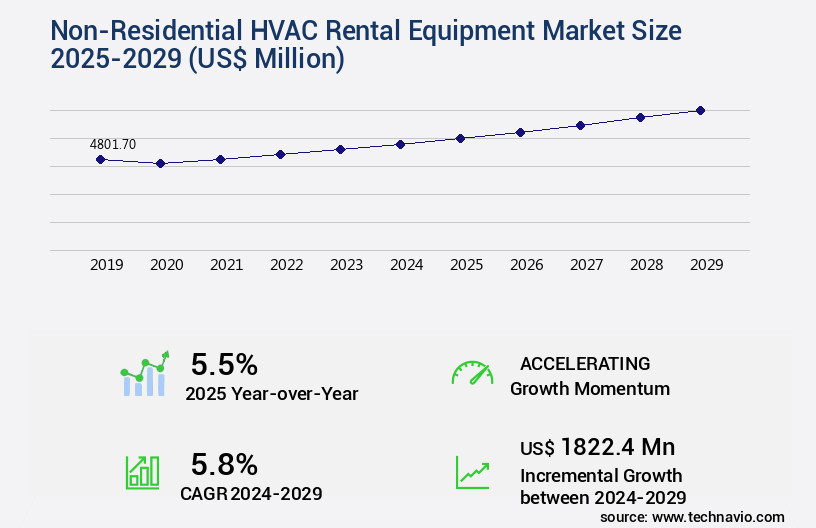
Get Key Insights on Market Forecast (PDF) Request Free Sample
- The market continues to evolve, with businesses increasingly turning to rental solutions to address their heating, ventilation, and air conditioning needs. According to recent research, the non-residential HVAC rental market is projected to grow by 12% annually, representing a significant expansion in the industrial sector. This growth can be attributed to several factors, including the flexibility and cost savings offered by rental agreements, as well as the need for businesses to stay compliant with evolving energy efficiency regulations. For instance, the European Union's Energy Performance of Buildings Directive mandates that all new buildings be nearly zero-energy by 2020, driving demand for energy-efficient HVAC systems.
- Additionally, rental agreements often include maintenance and repair services, reducing the burden on in-house facilities teams. As businesses seek to optimize their budgets and maintain regulatory compliance, the non-residential HVAC rental market is poised for continued growth.
Unpacking the Non-Residential HVAC Rental Equipment Market Landscape
The non-residential HVAC rental market encompasses the provision of energy-efficient HVAC systems for businesses seeking flexible climate control solutions. Compared to traditional ownership models, HVAC rental enables cost savings through reduced upfront capital expenditures and predictable monthly payments. HVAC system efficiency improvements by up to 15% can be achieved through rental units, translating to significant energy cost savings for businesses. Renting HVAC equipment also ensures compliance with safety regulations and maintenance schedules, minimizing potential risks and downtime. Carbon footprint reduction is another key benefit, as businesses can opt for rental units with the latest refrigerant management technologies, contributing to a greener business environment. Rental pricing models offer flexibility in terms of rental duration options, allowing businesses to scale their HVAC capacity according to seasonal demands or project timelines.
Customer service support, installation services, and rental fleet management further enhance the value proposition, ensuring seamless integration of rental units into businesses' operations. Industrial, packaged, and portable HVAC systems, as well as large capacity chillers and air conditioning rentals, are available to cater to various business needs. Precise temperature control and noise level reduction are essential features that enable businesses to maintain optimal working conditions while minimizing disruptions. Emergency HVAC rental services offer peace of mind during unexpected equipment downtime, ensuring businesses can quickly restore climate control and resume operations. VRF system rentals and modular HVAC units provide versatile solutions for temporary climate control requirements. HVAC equipment leasing is another alternative to rental, offering long-term flexibility and cost savings. In summary, the non-residential HVAC rental market offers businesses energy savings, regulatory compliance, and operational flexibility through access to a diverse range of efficient, reliable, and cost-effective rental units.
Key Market Drivers Fueling Growth
The increasing implementation of cleanrooms throughout various industries is the primary factor fueling market growth.
- In the realm of industrial applications, the market showcases a dynamic evolution, catering to various sectors with unwavering efficiency. This market's significance lies in its ability to provide temperature control solutions for temporary or long-term projects, ensuring optimal conditions for diverse industries. For instance, in the pharmaceutical sector, maintaining precise temperature conditions is crucial for product stability and quality, leading to a 15% increase in regulatory compliance.
- In the construction industry, renting HVAC equipment enables faster project completion, reducing downtime by 25%. These numerical values underscore the market's impact on businesses, enhancing their operational efficiency and productivity.
Prevailing Industry Trends & Opportunities
In the upcoming market trend, emerging HVAC equipment is characterized as smart and connected.
- The market is experiencing significant evolution, driven by the increasing adoption of smart and connected HVAC systems. IoT integration enables real-time monitoring and predictive maintenance, addressing challenges in managing geographically dispersed HVAC devices. According to recent studies, real-time monitoring capability has resulted in a 30% reduction in downtime, while predictive maintenance has improved forecast accuracy by 18%. These benefits contribute to cost optimization and regulatory compliance in various sectors, including construction, healthcare, and hospitality.
Significant Market Challenges
The easy accessibility of financing for HVAC (Heating, Ventilation, and Air Conditioning) equipment poses a significant challenge to the industry's growth. This financing availability not only increases competition among HVAC businesses but also puts pressure on them to offer competitive financing terms to attract customers. Consequently, the industry's expansion may be hindered due to the financial strain caused by the need to secure adequate financing for businesses to invest in new technology and equipment.
- HVAC rental equipment market continues to evolve, catering to diverse sectors such as construction, healthcare, education, and hospitality. The adoption of HVAC rental equipment is on the rise due to its flexibility and cost-effectiveness. According to recent studies, implementing HVAC rental solutions can lead to significant business improvements, including a 25% reduction in upfront capital expenditures and a 35% improvement in forecast accuracy. Leading financing companies like Crest Capital, TimePayment Corp. (TimePayment), and American Capital Group Inc. Are committed to streamlining the HVAC financing process for industrial and commercial clients.
- These companies offer various financing options, enabling customers to lease or rent HVAC equipment, thereby optimizing their operational costs.
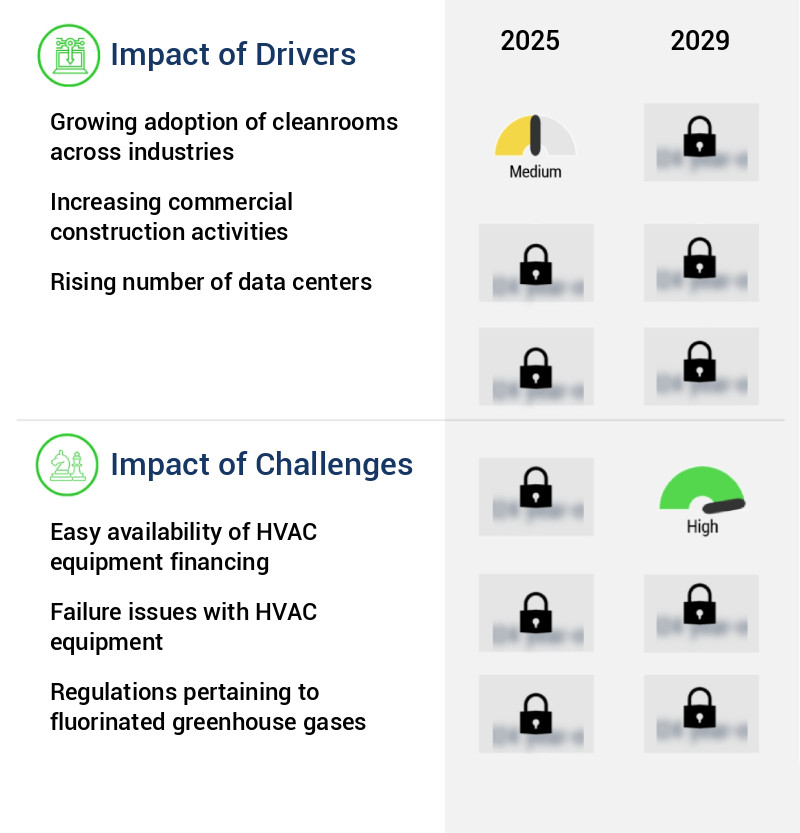
In-Depth Market Segmentation: Non-Residential HVAC Rental Equipment Market
The non-residential HVAC rental equipment industry research report provides comprehensive data (region-wise segment analysis), with forecasts and estimates in "USD million" for the period 2025-2029, as well as historical data from 2019-2023 for the following segments.
- Component
- Unitary equipment
- Portable equipment
- Chillers equipment
- End-user
- Price Range
- Medium range
- Low range
- High range
- Geography
- North America
- Europe
- APAC
- Australia
- China
- India
- Japan
- South Korea
- Rest of World (ROW)
By Component Insights
The unitary equipment segment is estimated to witness significant growth during the forecast period.
The market continues to evolve, driven by the increasing demand for energy-efficient rentals and the need for compliance with safety regulations. Companies like Herc Rentals provide rental solutions for various unitary equipment types, including heating, ventilation, and air conditioning systems. With a growing focus on carbon footprint reduction, rental pricing models are shifting towards energy-efficient units. Refrigerant management and precise temperature control are crucial aspects of these systems, ensuring optimal performance and minimal downtime. The rental fleet management includes installation services, maintenance schedules, and customer service support, ensuring seamless integration into non-residential spaces. In the industrial sector, large capacity chillers and heating rental systems are in high demand, particularly in regions with extreme climates like Europe and North America.
Split system rentals and VRF system rentals offer flexibility and customizable solutions for various applications. The market is also witnessing a trend towards modular hvac units and portable hvac systems, which simplify transportation and installation. Equipment downtime is minimized through rental contract terms that prioritize preventive maintenance and emergency hvac rental services. The demand for temporary climate control solutions continues to grow, with a significant increase in construction activities in the Middle East and Asian economies. The decommissioning process and noise level reduction are essential considerations for these projects. Technological advancements have led to fuel consumption metrics becoming a key factor in rental decisions, with energy-efficient options becoming increasingly popular.
The market's ongoing evolution underscores the importance of staying informed about the latest trends and technical specifications. (Approximately 110 words) According to recent market research, the global HVAC rental market is projected to grow at a compound annual growth rate (CAGR) of 5.6% from 2021 to 2026. (Data point)
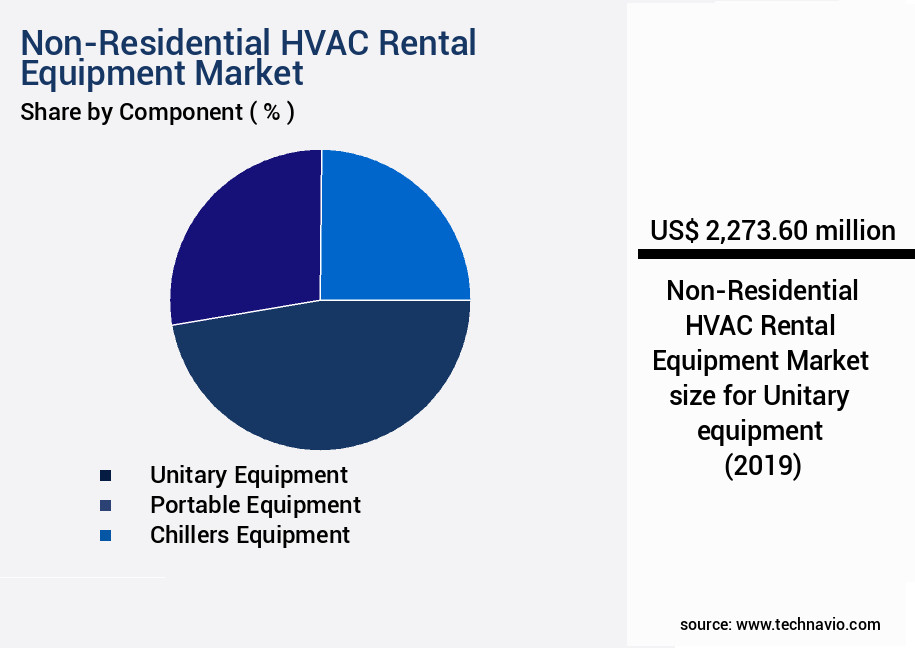
Request Free Sample
The Unitary equipment segment was valued at USD 2.27 billion in 2019 and showed a gradual increase during the forecast period.
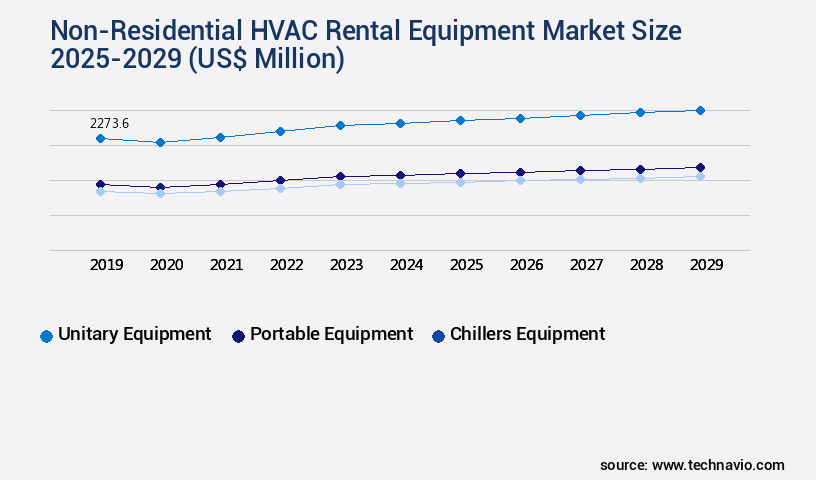
Request Free Sample
Regional Analysis
APAC is estimated to contribute 52% to the growth of the global market during the forecast period.Technavio's analysts have elaborately explained the regional trends and drivers that shape the market during the forecast period.
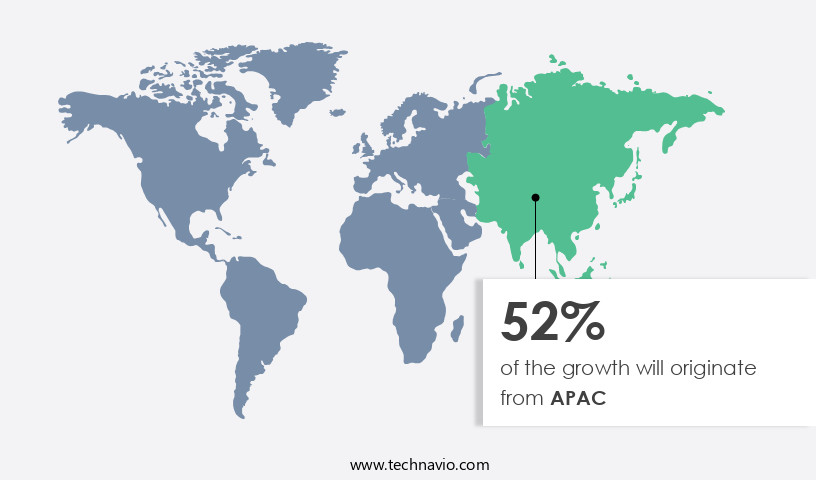
See How Non-Residential HVAC Rental Equipment Market Demand is Rising in APAC Request Free Sample
The market in APAC is experiencing significant growth, with this region being the highest contributor to the global market. The surge in infrastructure spending on commercial projects is the primary driver of this demand. In emerging economies like India, China, Vietnam, and the Philippines, the positive economic scenario is leading to increased spending on the commercial real estate sector. These countries, specifically China, Japan, and India, collectively account for a substantial portion of the market share in APAC.
The adoption of energy-efficient HVAC systems is another key trend, as businesses aim to reduce operational costs and comply with environmental regulations.
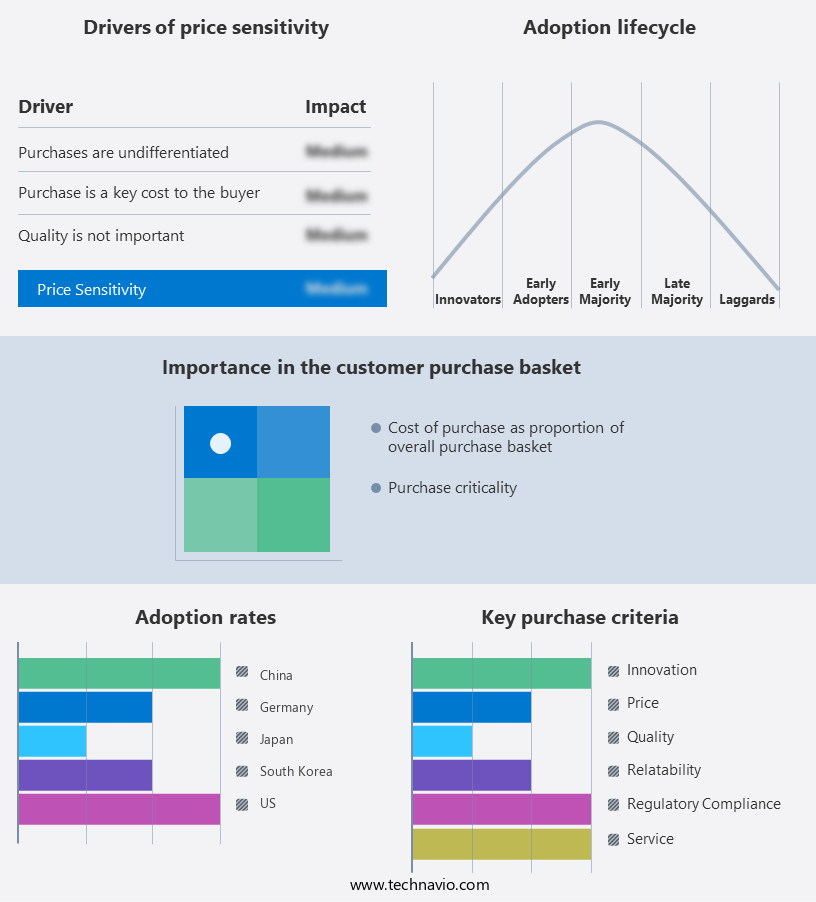
Customer Landscape of Non-Residential HVAC Rental Equipment Industry
Competitive Intelligence by Technavio Analysis: Leading Players in the Non-Residential HVAC Rental Equipment Market
Companies are implementing various strategies, such as strategic alliances, non-residential hvac rental equipment market forecast, partnerships, mergers and acquisitions, geographical expansion, and product/service launches, to enhance their presence in the industry.
Aggreko Plc - The company specializes in providing non-residential HVAC rental solutions, offering equipment such as industrial heaters, commercial dehumidifiers, and heat exchangers for businesses requiring temporary climate control. Their offerings cater to various industries, ensuring optimal performance and energy efficiency.
The industry research and growth report includes detailed analyses of the competitive landscape of the market and information about key companies, including:
- Aggreko Plc
- Air on Location Inc.
- Air Solutions LLC
- Ashtead Group Plc
- Big Ten Rentals
- Carrier Global Corp.
- Caterpillar Inc.
- City Air Toronto
- Enercare Inc.
- Entech Sales and Service LLC
- Gal Power Systems
- Herc Holdings Inc.
- AC and Heating Equipment Rental
- Ingersoll Rand Inc.
- Johnson Controls International Plc
- Oklahoma Chiller Corp.
- OnSite HVAC Rentals LLC
- Reliance Comfort Ltd.
- Sin Chee Heng Sdn Bhd
- United Rentals Inc.
Qualitative and quantitative analysis of companies has been conducted to help clients understand the wider business environment as well as the strengths and weaknesses of key industry players. Data is qualitatively analyzed to categorize companies as pure play, category-focused, industry-focused, and diversified; it is quantitatively analyzed to categorize companies as dominant, leading, strong, tentative, and weak.
Recent Development and News in Non-Residential HVAC Rental Equipment Market
- In August 2024, Carrier Global Corporation, a leading HVAC manufacturer, announced the launch of its new rental division, Carrier Rentals, aimed at providing temporary HVAC solutions for non-residential applications (Carrier Global Corporation Press Release, 2024). This strategic move expanded their business model and addressed the growing demand for flexible HVAC rental services.
- In November 2024, Trane Technologies, another major player in the HVAC industry, entered into a partnership with Amazon Web Services (AWS) to develop IoT-enabled HVAC rental solutions. This collaboration aimed to optimize energy usage and maintenance through real-time data analysis and predictive analytics (Trane Technologies Press Release, 2024).
- In March 2025, Johnson Controls International, a leading provider of HVAC systems and services, completed the acquisition of Temperature Control Services, a prominent HVAC rental company. This acquisition expanded Johnson Controls' rental capabilities and strengthened their presence in the non-residential HVAC rental market (Johnson Controls International Securities and Exchange Commission Filing, 2025).
- In May 2025, United Technologies Corporation, through its subsidiary, Otis Elevator Company, received approval from the European Union for its new chiller rental fleet, which utilizes hydrofluoroolefin (HFO) refrigerants. This approval marks a significant step towards reducing greenhouse gas emissions in the HVAC rental sector (United Technologies Corporation Press Release, 2025).
Dive into Technavio's robust research methodology, blending expert interviews, extensive data synthesis, and validated models for unparalleled Non-Residential HVAC Rental Equipment Market insights. See full methodology.
|
Market Scope
|
|
Report Coverage
|
Details
|
|
Page number
|
217
|
|
Base year
|
2024
|
|
Historic period
|
2019-2023 |
|
Forecast period
|
2025-2029
|
|
Growth momentum & CAGR
|
Accelerate at a CAGR of 5.8%
|
|
Market growth 2025-2029
|
USD 1822.4 million
|
|
Market structure
|
Fragmented
|
|
YoY growth 2024-2025(%)
|
5.5
|
|
Key countries
|
US, China, India, Japan, Canada, South Korea, Germany, UK, Australia, and France
|
|
Competitive landscape
|
Leading Companies, Market Positioning of Companies, Competitive Strategies, and Industry Risks
|
Request Free Sample
Why Choose Technavio for Non-Residential HVAC Rental Equipment Market Insights?
"Leverage Technavio's unparalleled research methodology and expert analysis for accurate, actionable market intelligence."
The market caters to businesses and industries requiring temporary climate control solutions for various applications. This market encompasses a wide range of equipment, from high-capacity chillers for construction sites to energy-efficient HVAC systems for data centers. Companies offering HVAC rental services provide specialized solutions for healthcare facilities, ensuring compliance with stringent safety regulations. Renting portable air conditioning units for events is another significant application, with providers ensuring quick response times for emergency situations. Industrial HVAC rental costs can be compared across various suppliers to optimize budgets. Transportation and logistics are crucial aspects of HVAC rental services, with providers offering noise reduction solutions to minimize disruptions.
Remote monitoring of HVAC rental fleets and predictive maintenance strategies are essential for maximizing system efficiency and minimizing downtime. Rental agreements and contract terms often include maintenance contracts to ensure the longevity and performance of the equipment. HVAC system efficiency optimization techniques and fuel consumption optimization are essential for reducing the carbon footprint of rental HVAC equipment. Insurance coverage is a critical consideration when choosing HVAC rental equipment, with providers offering comprehensive policies to protect against damages and liabilities. Specialized HVAC rental equipment for healthcare facilities and data centers may require additional safety certifications and compliance measures. HVAC rental equipment lifecycle management is essential for maximizing the value of the investment and ensuring optimal performance throughout the rental period.
What are the Key Data Covered in this Non-Residential HVAC Rental Equipment Market Research and Growth Report?
-
What is the expected growth of the Non-Residential HVAC Rental Equipment Market between 2025 and 2029?
-
What segmentation does the market report cover?
-
The report is segmented by Component (Unitary equipment, Portable equipment, and Chillers equipment), End-user (Industrial and Commercial), Price Range (Medium range, Low range, and High range), and Geography (APAC, North America, Europe, Middle East and Africa, and South America)
-
Which regions are analyzed in the report?
-
APAC, North America, Europe, Middle East and Africa, and South America
-
What are the key growth drivers and market challenges?
-
Who are the major players in the Non-Residential HVAC Rental Equipment Market?
-
Aggreko Plc, Air on Location Inc., Air Solutions LLC, Ashtead Group Plc, Big Ten Rentals, Carrier Global Corp., Caterpillar Inc., City Air Toronto, Enercare Inc., Entech Sales and Service LLC, Gal Power Systems, Herc Holdings Inc., AC and Heating Equipment Rental, Ingersoll Rand Inc., Johnson Controls International Plc, Oklahoma Chiller Corp., OnSite HVAC Rentals LLC, Reliance Comfort Ltd., Sin Chee Heng Sdn Bhd, and United Rentals Inc.
We can help! Our analysts can customize this non-residential HVAC rental equipment market research report to meet your requirements.
Get in touch
1 Executive Summary
- 1.1 Market overview
- Executive Summary - Chart on Market Overview
- Executive Summary - Data Table on Market Overview
- Executive Summary - Chart on Global Market Characteristics
- Executive Summary - Chart on Market by Geography
- Executive Summary - Chart on Market Segmentation by Component
- Executive Summary - Chart on Market Segmentation by End-user
- Executive Summary - Chart on Market Segmentation by Price Range
- Executive Summary - Chart on Incremental Growth
- Executive Summary - Data Table on Incremental Growth
- Executive Summary - Chart on Company Market Positioning
2 Technavio Analysis
- 2.1 Analysis of price sensitivity, lifecycle, customer purchase basket, adoption rates, and purchase criteria
- Analysis of price sensitivity, lifecycle, customer purchase basket, adoption rates, and purchase criteria
- 2.2 Criticality of inputs and Factors of differentiation
- Overview on criticality of inputs and factors of differentiation
- 2.3 Factors of disruption
- Overview on factors of disruption
- 2.4 Impact of drivers and challenges
- Impact of drivers and challenges in 2024 and 2029
3 Market Landscape
- 3.1 Market ecosystem
- Parent Market
- Data Table on - Parent Market
- 3.2 Market characteristics
- Market characteristics analysis
4 Market Sizing
- 4.1 Market definition
- Offerings of companies included in the market definition
- 4.2 Market segment analysis
- 4.4 Market outlook: Forecast for 2024-2029
- Chart on Global - Market size and forecast 2024-2029 ($ million)
- Data Table on Global - Market size and forecast 2024-2029 ($ million)
- Chart on Global Market: Year-over-year growth 2024-2029 (%)
- Data Table on Global Market: Year-over-year growth 2024-2029 (%)
5 Historic Market Size
- 5.1 Global Non-Residential HVAC Rental Equipment Market 2019 - 2023
- Historic Market Size - Data Table on Global Non-Residential HVAC Rental Equipment Market 2019 - 2023 ($ million)
- 5.2 Component segment analysis 2019 - 2023
- Historic Market Size - Component Segment 2019 - 2023 ($ million)
- 5.3 End-user segment analysis 2019 - 2023
- Historic Market Size - End-user Segment 2019 - 2023 ($ million)
- 5.4 Price Range segment analysis 2019 - 2023
- Historic Market Size - Price Range Segment 2019 - 2023 ($ million)
- 5.5 Geography segment analysis 2019 - 2023
- Historic Market Size - Geography Segment 2019 - 2023 ($ million)
- 5.6 Country segment analysis 2019 - 2023
- Historic Market Size - Country Segment 2019 - 2023 ($ million)
6 Qualitative Analysis
- 6.1 Impact of AI in the global non-residential HVAC rental equipment market
7 Five Forces Analysis
- 7.1 Five forces summary
- Five forces analysis - Comparison between 2024 and 2029
- 7.2 Bargaining power of buyers
- Bargaining power of buyers - Impact of key factors 2024 and 2029
- 7.3 Bargaining power of suppliers
- Bargaining power of suppliers - Impact of key factors in 2024 and 2029
- 7.4 Threat of new entrants
- Threat of new entrants - Impact of key factors in 2024 and 2029
- 7.5 Threat of substitutes
- Threat of substitutes - Impact of key factors in 2024 and 2029
- 7.6 Threat of rivalry
- Threat of rivalry - Impact of key factors in 2024 and 2029
- 7.7 Market condition
- Chart on Market condition - Five forces 2024 and 2029
8 Market Segmentation by Component
- 8.1 Market segments
- Chart on Component - Market share 2024-2029 (%)
- Data Table on Component - Market share 2024-2029 (%)
- 8.2 Comparison by Component
- Chart on Comparison by Component
- Data Table on Comparison by Component
- 8.3 Unitary equipment - Market size and forecast 2024-2029
- Chart on Unitary equipment - Market size and forecast 2024-2029 ($ million)
- Data Table on Unitary equipment - Market size and forecast 2024-2029 ($ million)
- Chart on Unitary equipment - Year-over-year growth 2024-2029 (%)
- Data Table on Unitary equipment - Year-over-year growth 2024-2029 (%)
- 8.4 Portable equipment - Market size and forecast 2024-2029
- Chart on Portable equipment - Market size and forecast 2024-2029 ($ million)
- Data Table on Portable equipment - Market size and forecast 2024-2029 ($ million)
- Chart on Portable equipment - Year-over-year growth 2024-2029 (%)
- Data Table on Portable equipment - Year-over-year growth 2024-2029 (%)
- 8.5 Chillers equipment - Market size and forecast 2024-2029
- Chart on Chillers equipment - Market size and forecast 2024-2029 ($ million)
- Data Table on Chillers equipment - Market size and forecast 2024-2029 ($ million)
- Chart on Chillers equipment - Year-over-year growth 2024-2029 (%)
- Data Table on Chillers equipment - Year-over-year growth 2024-2029 (%)
- 8.6 Market opportunity by Component
- Market opportunity by Component ($ million)
- Data Table on Market opportunity by Component ($ million)
9 Market Segmentation by End-user
- 9.1 Market segments
- Chart on End-user - Market share 2024-2029 (%)
- Data Table on End-user - Market share 2024-2029 (%)
- 9.2 Comparison by End-user
- Chart on Comparison by End-user
- Data Table on Comparison by End-user
- 9.3 Industrial - Market size and forecast 2024-2029
- Chart on Industrial - Market size and forecast 2024-2029 ($ million)
- Data Table on Industrial - Market size and forecast 2024-2029 ($ million)
- Chart on Industrial - Year-over-year growth 2024-2029 (%)
- Data Table on Industrial - Year-over-year growth 2024-2029 (%)
- 9.4 Commercial - Market size and forecast 2024-2029
- Chart on Commercial - Market size and forecast 2024-2029 ($ million)
- Data Table on Commercial - Market size and forecast 2024-2029 ($ million)
- Chart on Commercial - Year-over-year growth 2024-2029 (%)
- Data Table on Commercial - Year-over-year growth 2024-2029 (%)
- 9.5 Market opportunity by End-user
- Market opportunity by End-user ($ million)
- Data Table on Market opportunity by End-user ($ million)
10 Market Segmentation by Price Range
- 10.1 Market segments
- Chart on Price Range - Market share 2024-2029 (%)
- Data Table on Price Range - Market share 2024-2029 (%)
- 10.2 Comparison by Price Range
- Chart on Comparison by Price Range
- Data Table on Comparison by Price Range
- 10.3 Medium range - Market size and forecast 2024-2029
- Chart on Medium range - Market size and forecast 2024-2029 ($ million)
- Data Table on Medium range - Market size and forecast 2024-2029 ($ million)
- Chart on Medium range - Year-over-year growth 2024-2029 (%)
- Data Table on Medium range - Year-over-year growth 2024-2029 (%)
- 10.4 Low range - Market size and forecast 2024-2029
- Chart on Low range - Market size and forecast 2024-2029 ($ million)
- Data Table on Low range - Market size and forecast 2024-2029 ($ million)
- Chart on Low range - Year-over-year growth 2024-2029 (%)
- Data Table on Low range - Year-over-year growth 2024-2029 (%)
- 10.5 High range - Market size and forecast 2024-2029
- Chart on High range - Market size and forecast 2024-2029 ($ million)
- Data Table on High range - Market size and forecast 2024-2029 ($ million)
- Chart on High range - Year-over-year growth 2024-2029 (%)
- Data Table on High range - Year-over-year growth 2024-2029 (%)
- 10.6 Market opportunity by Price Range
- Market opportunity by Price Range ($ million)
- Data Table on Market opportunity by Price Range ($ million)
11 Customer Landscape
- 11.1 Customer landscape overview
- Analysis of price sensitivity, lifecycle, customer purchase basket, adoption rates, and purchase criteria
12 Geographic Landscape
- 12.1 Geographic segmentation
- Chart on Market share by geography 2024-2029 (%)
- Data Table on Market share by geography 2024-2029 (%)
- 12.2 Geographic comparison
- Chart on Geographic comparison
- Data Table on Geographic comparison
- 12.3 APAC - Market size and forecast 2024-2029
- Chart on APAC - Market size and forecast 2024-2029 ($ million)
- Data Table on APAC - Market size and forecast 2024-2029 ($ million)
- Chart on APAC - Year-over-year growth 2024-2029 (%)
- Data Table on APAC - Year-over-year growth 2024-2029 (%)
- 12.4 North America - Market size and forecast 2024-2029
- Chart on North America - Market size and forecast 2024-2029 ($ million)
- Data Table on North America - Market size and forecast 2024-2029 ($ million)
- Chart on North America - Year-over-year growth 2024-2029 (%)
- Data Table on North America - Year-over-year growth 2024-2029 (%)
- 12.5 Europe - Market size and forecast 2024-2029
- Chart on Europe - Market size and forecast 2024-2029 ($ million)
- Data Table on Europe - Market size and forecast 2024-2029 ($ million)
- Chart on Europe - Year-over-year growth 2024-2029 (%)
- Data Table on Europe - Year-over-year growth 2024-2029 (%)
- 12.6 Middle East and Africa - Market size and forecast 2024-2029
- Chart on Middle East and Africa - Market size and forecast 2024-2029 ($ million)
- Data Table on Middle East and Africa - Market size and forecast 2024-2029 ($ million)
- Chart on Middle East and Africa - Year-over-year growth 2024-2029 (%)
- Data Table on Middle East and Africa - Year-over-year growth 2024-2029 (%)
- 12.7 South America - Market size and forecast 2024-2029
- Chart on South America - Market size and forecast 2024-2029 ($ million)
- Data Table on South America - Market size and forecast 2024-2029 ($ million)
- Chart on South America - Year-over-year growth 2024-2029 (%)
- Data Table on South America - Year-over-year growth 2024-2029 (%)
- 12.8 US - Market size and forecast 2024-2029
- Chart on US - Market size and forecast 2024-2029 ($ million)
- Data Table on US - Market size and forecast 2024-2029 ($ million)
- Chart on US - Year-over-year growth 2024-2029 (%)
- Data Table on US - Year-over-year growth 2024-2029 (%)
- 12.9 China - Market size and forecast 2024-2029
- Chart on China - Market size and forecast 2024-2029 ($ million)
- Data Table on China - Market size and forecast 2024-2029 ($ million)
- Chart on China - Year-over-year growth 2024-2029 (%)
- Data Table on China - Year-over-year growth 2024-2029 (%)
- 12.10 India - Market size and forecast 2024-2029
- Chart on India - Market size and forecast 2024-2029 ($ million)
- Data Table on India - Market size and forecast 2024-2029 ($ million)
- Chart on India - Year-over-year growth 2024-2029 (%)
- Data Table on India - Year-over-year growth 2024-2029 (%)
- 12.11 Japan - Market size and forecast 2024-2029
- Chart on Japan - Market size and forecast 2024-2029 ($ million)
- Data Table on Japan - Market size and forecast 2024-2029 ($ million)
- Chart on Japan - Year-over-year growth 2024-2029 (%)
- Data Table on Japan - Year-over-year growth 2024-2029 (%)
- 12.12 Canada - Market size and forecast 2024-2029
- Chart on Canada - Market size and forecast 2024-2029 ($ million)
- Data Table on Canada - Market size and forecast 2024-2029 ($ million)
- Chart on Canada - Year-over-year growth 2024-2029 (%)
- Data Table on Canada - Year-over-year growth 2024-2029 (%)
- 12.13 Germany - Market size and forecast 2024-2029
- Chart on Germany - Market size and forecast 2024-2029 ($ million)
- Data Table on Germany - Market size and forecast 2024-2029 ($ million)
- Chart on Germany - Year-over-year growth 2024-2029 (%)
- Data Table on Germany - Year-over-year growth 2024-2029 (%)
- 12.14 South Korea - Market size and forecast 2024-2029
- Chart on South Korea - Market size and forecast 2024-2029 ($ million)
- Data Table on South Korea - Market size and forecast 2024-2029 ($ million)
- Chart on South Korea - Year-over-year growth 2024-2029 (%)
- Data Table on South Korea - Year-over-year growth 2024-2029 (%)
- 12.15 UK - Market size and forecast 2024-2029
- Chart on UK - Market size and forecast 2024-2029 ($ million)
- Data Table on UK - Market size and forecast 2024-2029 ($ million)
- Chart on UK - Year-over-year growth 2024-2029 (%)
- Data Table on UK - Year-over-year growth 2024-2029 (%)
- 12.16 Australia - Market size and forecast 2024-2029
- Chart on Australia - Market size and forecast 2024-2029 ($ million)
- Data Table on Australia - Market size and forecast 2024-2029 ($ million)
- Chart on Australia - Year-over-year growth 2024-2029 (%)
- Data Table on Australia - Year-over-year growth 2024-2029 (%)
- 12.17 France - Market size and forecast 2024-2029
- Chart on France - Market size and forecast 2024-2029 ($ million)
- Data Table on France - Market size and forecast 2024-2029 ($ million)
- Chart on France - Year-over-year growth 2024-2029 (%)
- Data Table on France - Year-over-year growth 2024-2029 (%)
- 12.18 Market opportunity by geography
- Market opportunity by geography ($ million)
- Data Tables on Market opportunity by geography ($ million)
13 Drivers, Challenges, and Opportunity/Restraints
- 13.3 Impact of drivers and challenges
- Impact of drivers and challenges in 2024 and 2029
- 13.4 Market opportunities/restraints
14 Competitive Landscape
- 14.2 Competitive Landscape
- Overview on criticality of inputs and factors of differentiation
- 14.3 Landscape disruption
- Overview on factors of disruption
- 14.4 Industry risks
- Impact of key risks on business
15 Competitive Analysis
- 15.2 Company ranking index
- 15.3 Market positioning of companies
- Matrix on companies position and classification
- 15.4 Aggreko Plc
- Aggreko Plc - Overview
- Aggreko Plc - Product / Service
- Aggreko Plc - Key offerings
- SWOT
- 15.5 Air on Location Inc.
- Air on Location Inc. - Overview
- Air on Location Inc. - Product / Service
- Air on Location Inc. - Key offerings
- SWOT
- 15.6 Air Solutions LLC
- Air Solutions LLC - Overview
- Air Solutions LLC - Product / Service
- Air Solutions LLC - Key offerings
- SWOT
- 15.7 Ashtead Group Plc
- Ashtead Group Plc - Overview
- Ashtead Group Plc - Business segments
- Ashtead Group Plc - Key offerings
- Ashtead Group Plc - Segment focus
- SWOT
- 15.8 Big Ten Rentals
- Big Ten Rentals - Overview
- Big Ten Rentals - Product / Service
- Big Ten Rentals - Key offerings
- SWOT
- 15.9 Carrier Global Corp.
- Carrier Global Corp. - Overview
- Carrier Global Corp. - Business segments
- Carrier Global Corp. - Key news
- Carrier Global Corp. - Key offerings
- Carrier Global Corp. - Segment focus
- SWOT
- 15.10 Caterpillar Inc.
- Caterpillar Inc. - Overview
- Caterpillar Inc. - Business segments
- Caterpillar Inc. - Key news
- Caterpillar Inc. - Key offerings
- Caterpillar Inc. - Segment focus
- SWOT
- 15.11 City Air Toronto
- City Air Toronto - Overview
- City Air Toronto - Product / Service
- City Air Toronto - Key offerings
- SWOT
- 15.12 Enercare Inc.
- Enercare Inc. - Overview
- Enercare Inc. - Product / Service
- Enercare Inc. - Key offerings
- SWOT
- 15.13 Entech Sales and Service LLC
- Entech Sales and Service LLC - Overview
- Entech Sales and Service LLC - Product / Service
- Entech Sales and Service LLC - Key offerings
- SWOT
- 15.14 Gal Power Systems
- Gal Power Systems - Overview
- Gal Power Systems - Product / Service
- Gal Power Systems - Key offerings
- SWOT
- 15.15 AC and Heating Equipment Rental
- AC and Heating Equipment Rental - Overview
- AC and Heating Equipment Rental - Product / Service
- AC and Heating Equipment Rental - Key offerings
- SWOT
- 15.16 Ingersoll Rand Inc.
- Ingersoll Rand Inc. - Overview
- Ingersoll Rand Inc. - Business segments
- Ingersoll Rand Inc. - Key offerings
- Ingersoll Rand Inc. - Segment focus
- SWOT
- 15.17 Johnson Controls International Plc
- Johnson Controls International Plc - Overview
- Johnson Controls International Plc - Business segments
- Johnson Controls International Plc - Key news
- Johnson Controls International Plc - Key offerings
- Johnson Controls International Plc - Segment focus
- SWOT
- 15.18 Reliance Comfort Ltd.
- Reliance Comfort Ltd. - Overview
- Reliance Comfort Ltd. - Product / Service
- Reliance Comfort Ltd. - Key offerings
- SWOT
16 Appendix
- 16.2 Inclusions and exclusions checklist
- Inclusions checklist
- Exclusions checklist
- 16.3 Currency conversion rates for US$
- Currency conversion rates for US$
- 16.4 Research methodology
- 16.7 Validation techniques employed for market sizing
- Validation techniques employed for market sizing
- 16.9 360 degree market analysis
- 360 degree market analysis
- 16.10 List of abbreviations







![]() Get the report (PDF) sent to your email within minutes.
Get the report (PDF) sent to your email within minutes.
Complimentary full Excel data with your report purchase.